|
Havana, Cuba 26th April
- 9th May 2004 |
|
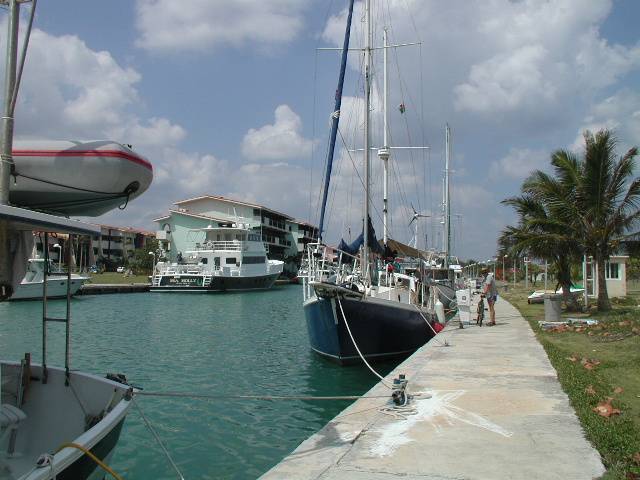
Anju in Canal 2 of Marina
Hemingway. The canals were so long, the bikes were needed just
to get to the bathroom!
|
Havana's Marina Hemingway is actually about
10 miles west of the centre of Old Havana but we were able to get easily
into the city centre on the bus service provided by one of the many
neighbouring tourist hotels.
On our trip into town, we shared our bus with
many Venezuelans, who we later learned, when we recognised our fellow
passengers on TV, were in Cuba for medical
treatment. Cuba had also recently sent many doctors to work in
Venezuela. It was very interesting, having recently spent time in
Venezuela as well, to see the strength of the link between the two countries
and to watch programmes on Cuban TV depicting their view of life in
Venezuela and about their reportedly "booming" economy.
|
|
On our first trip into the old city, we were
expecting to find ourselves surrounded by buildings in need of a little
repair and a coat of paint, as we had in the other towns we had
visited. However, as we approached the old town, we were quite shocked
at the state of many of the buildings on the city's famous Malecon, or
seafront and in the nearby back streets. Rather than
needing a little attention, many seemed to be slowly crumbling away.
However, restoration was slowly under way and many of the city's major
landmarks have already been beautifully restored, with other buildings presumably being
restored when funds were available from UNESCO or other partners.
|
|
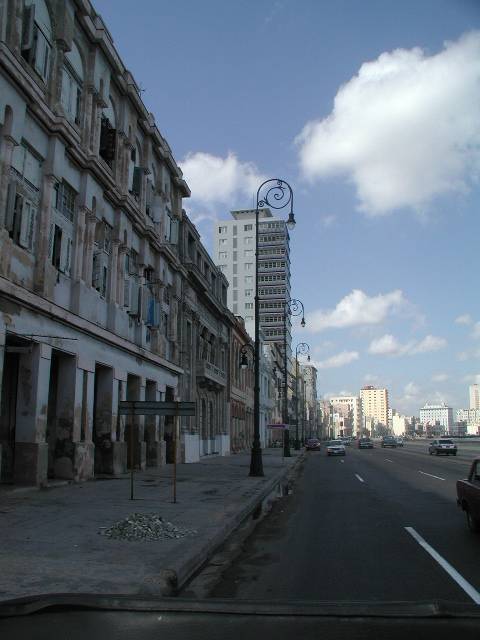
The Malecon - Slowly
Crumbling Away.
|
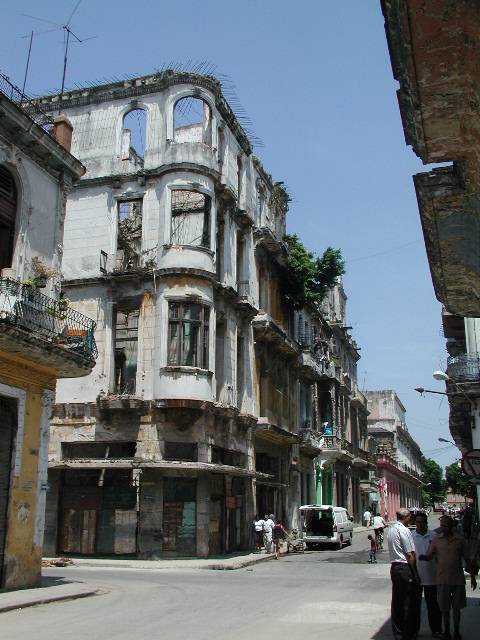
Havana Life Continues
amongst the crumbling buildings.
|
|
Our next overwhelming impression of Havana was
of the constant attention of the many street hustlers and beggars, which
quickly became very wearing. We were constantly approached
to be offered tours of the city, meals in people's houses and by grannies
asking for dollars, mothers asking us to buy milk for their babies
(apparently it is provided as part of the monthly ration for all young
children). Most often we were offered cigars, which had
"disappeared" from the various cigar factories and were offered
with all the official packaging for a fraction of the cost, often by factory
workers with IDs to prove it. Once
we were even offered cut price paint - they must have known we had a steel
boat!
|
|
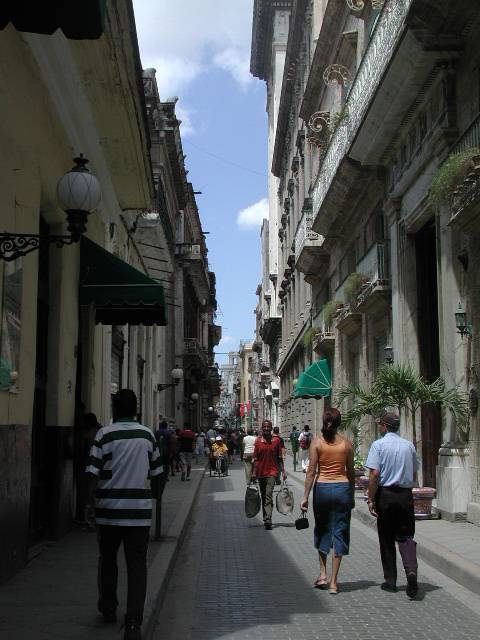
Obispo, the city's main
pedestrian street where many buildings were already beautifully restored.
|
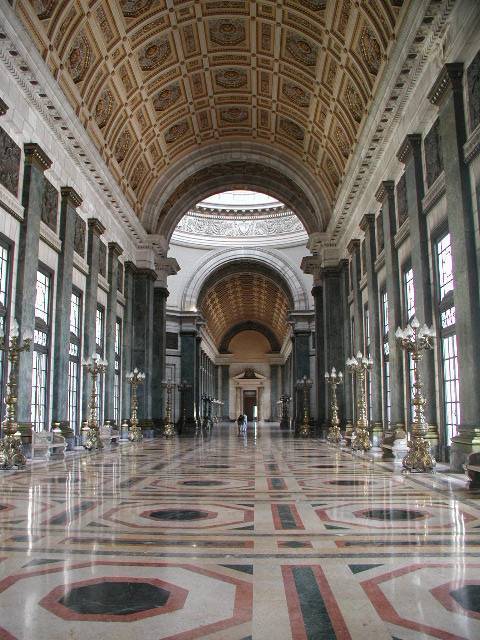
The Stunning Capitolio
Nacional Building.
|
|
Quite quickly we became short with all people
approaching us, which was a shame as there were also many people just
genuinely curious about where we were from and wanting to chat to practice
their English. Even in the museums, we'd be grabbed by the arm
and ushered away to see areas normally closed off to the public but as we left, on some occasions we
were asked for extra money by the curators and although they were often
genuinely in need, the entry fees to the city's landmarks were already high,
so it was rather irritating. On other occasions however, the
curators were just keen for us to see all of the building with no ulterior
motive and couldn't understand our reluctance. We felt the
constant hassle spoiled our visits to the old city a little.
|
|
On one occasion we did succumb to the charms of
one of the salesmen, Benjamin, guide on a horse drawn carriage, who with the
driver Ernesto, took us on in interesting tour around the highlights of the
old city, which helped us get our bearings.
Next we visited the very impressive Capitolio
building, which bears a striking resemblance to the Capitol building in
Washington apparently. Hopefully we'll check for ourselves later
in the year. Prior to the revolution, the Capitolio was the seat
of the government. We took the opportunity to use the bathrooms
while we were there and for the very reasonable fee of 20 cents, had
personal attention from the attendant, who would knock to check if you needed
additional sheets of toilet paper beyond your allocated allowance and then help you wash your hands!
|
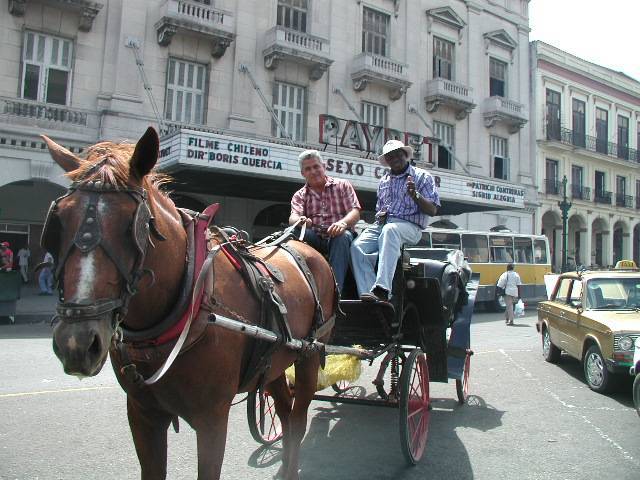
Our transport around
Havana.
|
|
By now we were hungry and decided to try a cafe
we'd seen, which sold food in the local Cuban Peso currency and was packed
with locals. Normally it is very difficult to spend Pesos if you
are a tourist. In the bars and restaurants for locals, where
prices are shown in Pesos, there is normally a different dollar pricing structure for
tourists. Even in this cafe, when we came to pay with our pesos, the
prices for the crazy gringos were different to the price list with no real
explanation. It was a great place to get a flavour of
local Cuban life and the fresh fruit juices were
delicious. Having seen the selection of snacks available
on display, looking a little lost in an impressive cabinet and being unable to chose between the sad looking ham sandwich,
the fritter of vegetable protein and the vividly coloured pink cake, we
decided to splash out and have the beans and rice with pork and of course
tomato salad instead. We had to follow this up
with a piece of the vivid cake, which cost only 1 peso. When you
held out your peso the piece of cake was plonked unceremoniously in your
other hand - no pretensions to luxury here! We felt quite at home!
|
|
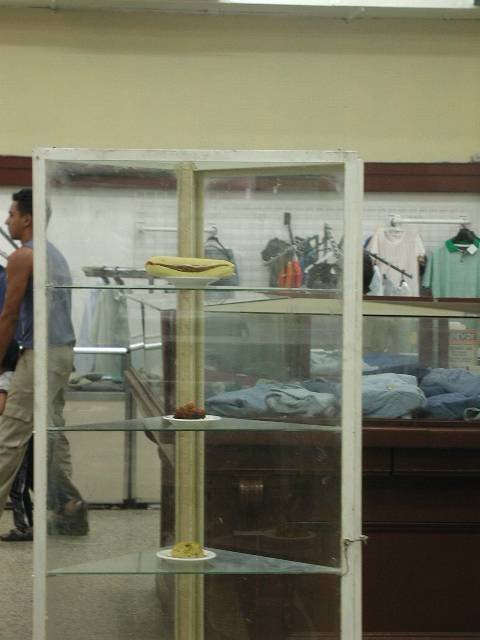
Spoiled for Choice at the
Peso Restaurant.
|
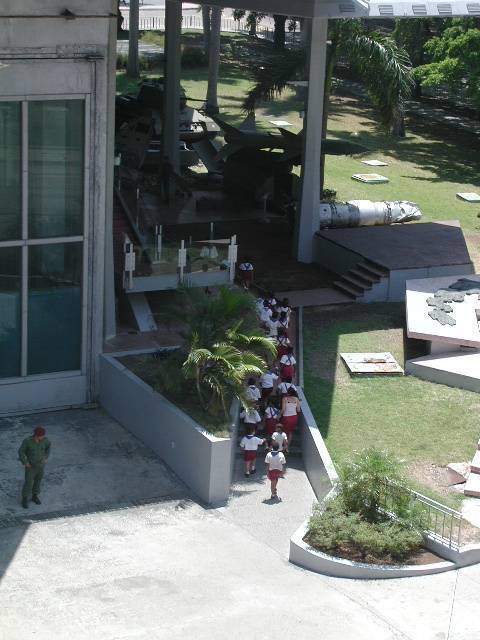
A school visit to the
Revolution Museum
|
|
Our next stop was at the Museum of the
Revolution, housed in the former presidential palace of the 1950s dictator Batista.
The museum gave a very informative display of all of Cuba's
revolutionary history and developments since 1959. Across the road
were housed a variety of vehicles, complete with bullet hoses, used during
battles, including armoured cars built by agricultural workers from tractors
and the boat "Granma" used to bring Castro and his men from Mexico
to start the revolution.
|
|
In keeping with the revolutionary theme, as we
were to be in Havana on May Day or "Workers' Day", we felt we had
to make our way to the Plaza de la Revolucion and try to catch of glimpse of
Fidel Castro giving his May Day speech. On seeing the crowds, we
felt we may be disappointed but slowly worked our way through the sea of
people towards his podium. We feared we were too late as many of
the crowd seemed to be heading away from the square but we could still hear
his speech being relayed over the numerous loudspeakers beside the road. On
our way we passed the Che Guevara monument, an impressive steel sculpture on
the side of a high rise building. Finally we were
close enough to catch glimpses of the famous revolutionary leader between
the crowd's heads and flags! Despite the fact that Fidel's
speeches have recently become much shorter than previously, due to his
advancing years, now only about 2 hours or so, we didn't have the stamina to
stay to the end.
|
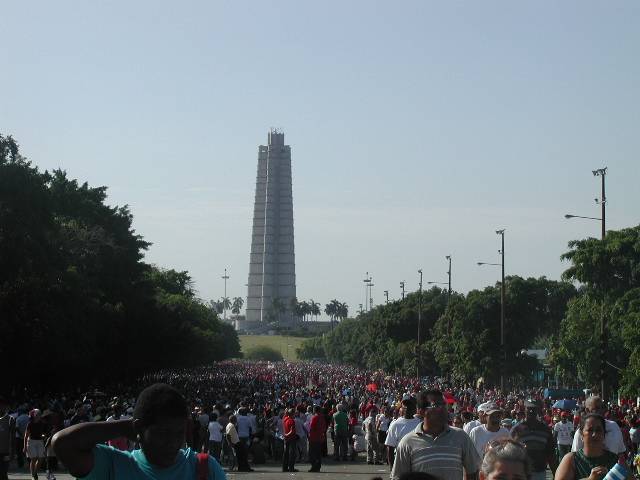
Making our way through a
sea of people to Revolution Square.
|
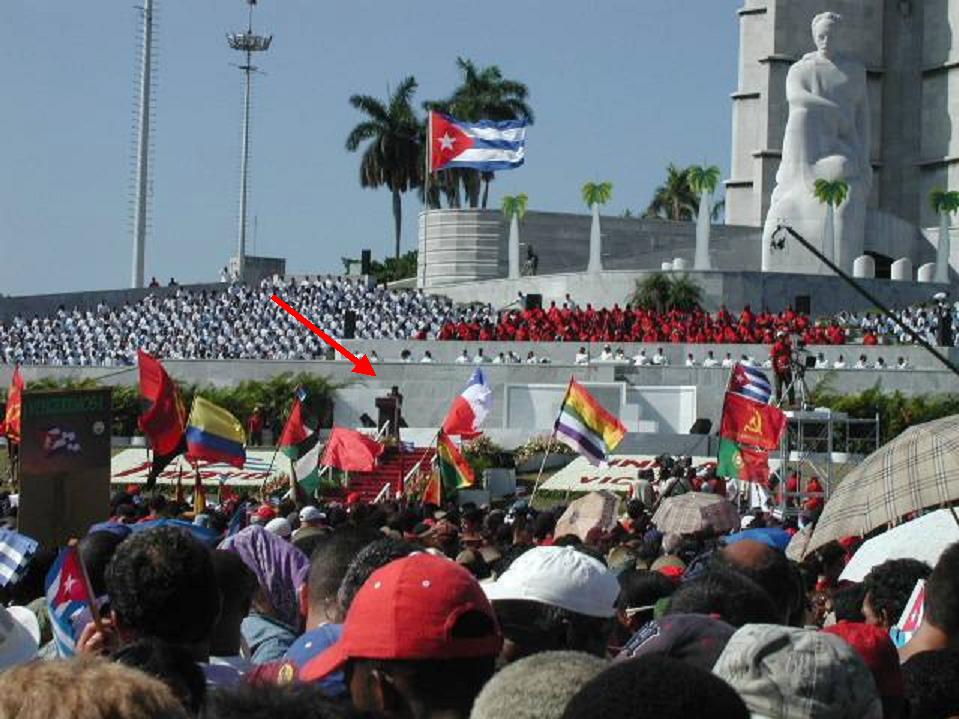
The day we saw Fidel
Castro!
|
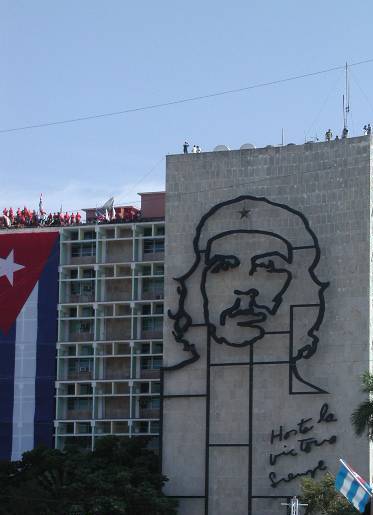
Che Guevara Monument
|
|
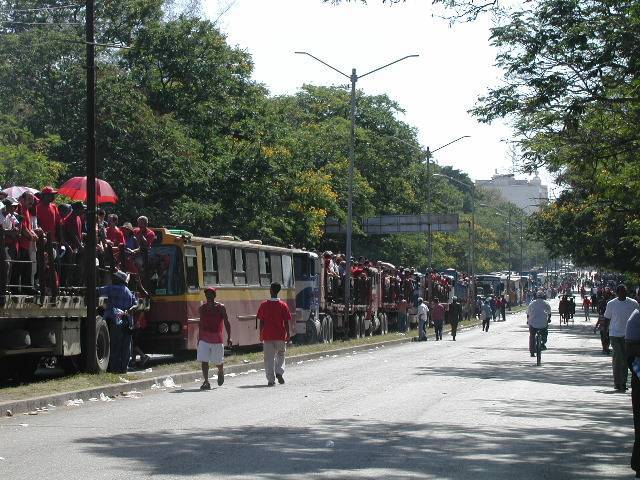
|
As we made our way back down the hill from Plaza
de la Revolucion to Old Havana, we were amazed at the number of buses lined
up, many were already full of people anxiously waiting to go home again,
standing in the baking sun, packed like sardines. It seemed that
many people were shipped in for the occasion. We only hoped they
didn't have to travel too far like that to get home again.
Further down the road, we started to encounter groups of people partying,
singing and dancing up the road and joined in the fun for a
while. At one point Phil was in danger of being abducted by a
woman in shocking pink. Things got really chaotic when a group
heading in one direction up the street would encounter another group, with
their own band, heading in the opposite direction.
|
|
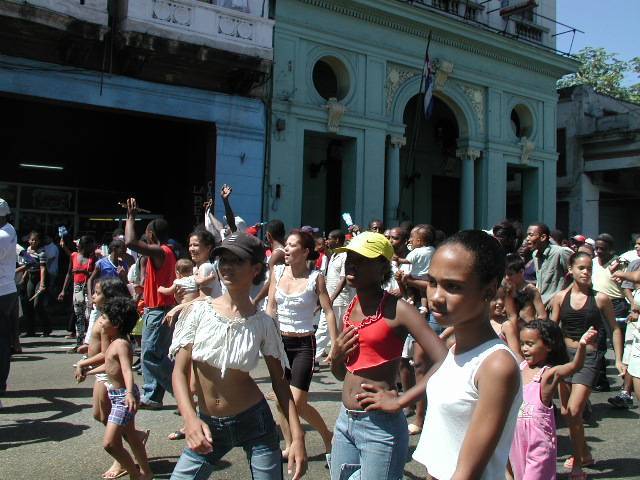
"Our crowd"
dancing back down the street to Old Havana.....
|
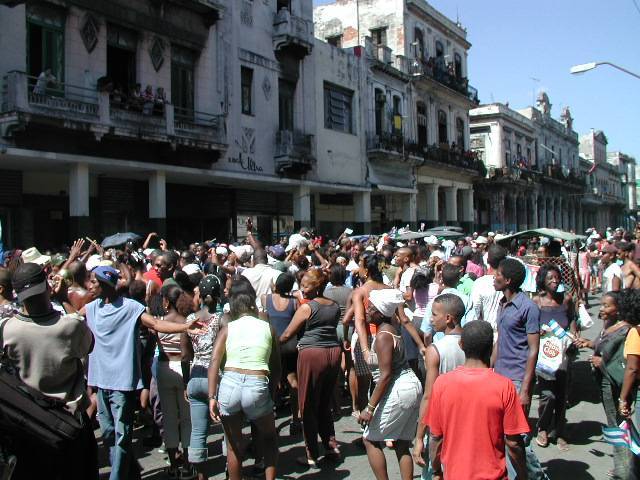
and passing another group
dancing the other way!
|
|
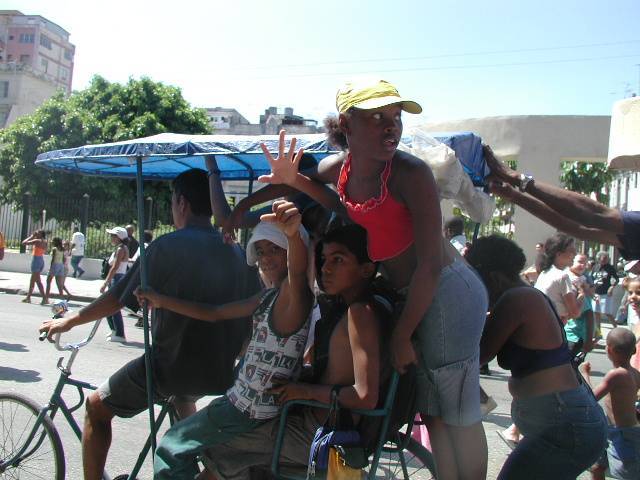
When you were too tired to
dance any more, you could grab a cab.
|
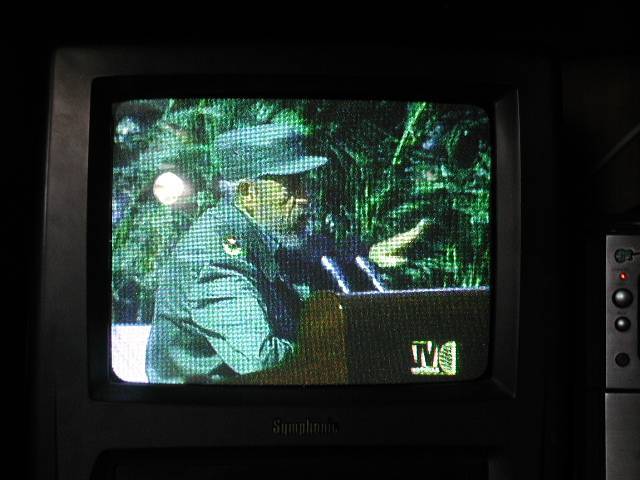
We needn't have worried about missing the
rest of the speech - the full 2 hours were repeated twice that day on TV!
|
|
One evening we were invited by friends Dan and
Carmel on HMS Cowheel to join them for a lobster dinner. The
dinner in the home of a chef by the beach was pre-booked for themselves and
their skipper but he wasn't feeling well so we had to galantly step in to
eat his lobster! The host Jesus, who normally works as a chef, had
built a thatch shelter in the garden right on the beach, it was a beautiful
spot to watch the sunset. He cooked lobster over a charcoal grill and they
were excellent served, of course, with rice and tomato salad. Phil, Dan and
Carmel drank lots of red wine and debated the merits of the revolution but
luckily didn't get arrested for their views, as they weren't Cuban!
|
|
Our next visit to old Havana was to visit the
Partagas Cigar Factory. Our tour started badly when Christine
got locked in the toilets and couldn't get out, causing quite a commotion in
the cigar shop. We were then told that most of the cigar factory
was closed but we could take the tour of the sorting and training areas and
the area where the cigars are made. That was enough for us,
especially when Phil pointed out that only half a tour should be only half
the cost and the staff agreed.
The work of making the cigars seemed quite
fiddley and each worker had to produced a fixed quantity each day.
During their work hours, the employees were entertained by a reader, who
would read them the newspaper in the morning and a novel in the
afternoon. There was even a quality tester, who sat at a table and
smoked cigars all day. We asked if he got paid danger money but got no
answer from our tour guide!
|
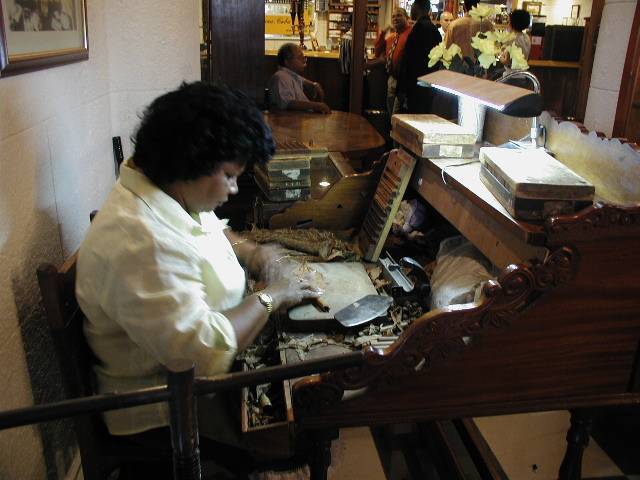
Making Cigars -
Demonstration in the shop (no photos allowed in the factory itself!)
|
|
We spent a challenging half day in Havana trying
to track down a market, so we could get fresh food supplies. The
vegetable market didn't take long to find and the selection was surprisingly
good, compared to others we'd visited. For a couple of pounds worth of
pesos, we were laden down with fresh veg and tomatoes too of
course! Eggs proved trickier to find and after 2 hours of
following false leads we finally gave up!
Our search gave us the opportunity to see
Havana's Chinatown, which is unusual in its lack of Chinese people and
things Chinese! We did find a fascinating department store which
seemed to contain lots of old car parts, spares for household gadgets, old
manual typewriters and photocopiers, all of which would have been more at
home in an antique shop back home (or maybe in the dustbin!). It
was very interesting.
During our remaining time in the marina, we
met some interesting cruising folk, including an Australian couple who'd had
to be towed in with a broken flexible coupling (lot of it
about!). A small boat was crowded with three Venezuelans
heading back to Puerto La Cruz in Venezuela from Miami. We
managed to make their life more comfortable by lending them some chairs to
sit on. We also took part in a "dock party", nibbles
and drinks on the dock, when we were able to meet our other neighbours
mainly from Canada.
|
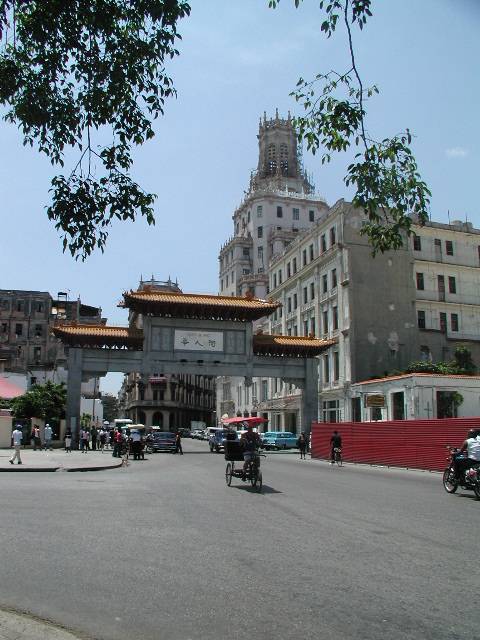
The entrance to Chinatown.
|
|
We felt it was time to head on to the United
States. Luckily on the day our visas expired, our weather
router, Chris, told us we'd have the best weather to cross to Florida that
we could expect for the next fortnight or so, so we decided to leave
Cuba. First we had to turn Anju around in the very
narrow channel with boats all around. Getting off the dock was tricky,
the wind was right on the nose but kept swapping from one side of the bow to
the other and of course, as soon as we started maneouvring off the dock, it
changed around again and tried to blow us back on. We were VERY close to the
boat in front but managed to get away without hitting it, with the help of
everyone around. In the process the dinghy caught on the electricity box on
the dock and one of its securing straps snapped. Someone
throwing a line aboard managed to hit the Navtex aerial and knock it off the
arch at the back of the boat - at least they didn't hit Norman the wind
generator!
So we set off out of Marina Hemingway already
stressed. As we were motoring to where we were told we had to stop to
check out, the many waiting officials indicated we should stop in a
different place, on a dock with the wind blowing hard from behind us. We
were already level with the dock, so we had to go past, turn around again in
the narrow channel, head back up and make another 180 degree turn before
trying to stop on the dock, which was almost impossible with 25 knots of
wind behind us (no brakes!). The officials eventually managed to grab
our lines to stop us. By now we were twice as stressed! Anyway, they
were all very polite and didn't ask for any "donations" as they
had with others apparently. They filled out their forms and
carried out a very superficial search of our boat, presumably for hidden
Cubans. When we told them we had to stay on their dock for a few
minutes while we cleaned the log (paddle wheel used to measure the boat
speed, which often stops working when small creatures take up residence in
it), they had to sit and watch us to make sure we didn't try to sneak
back into the country! About 7 pm we were off to Florida!
|

















